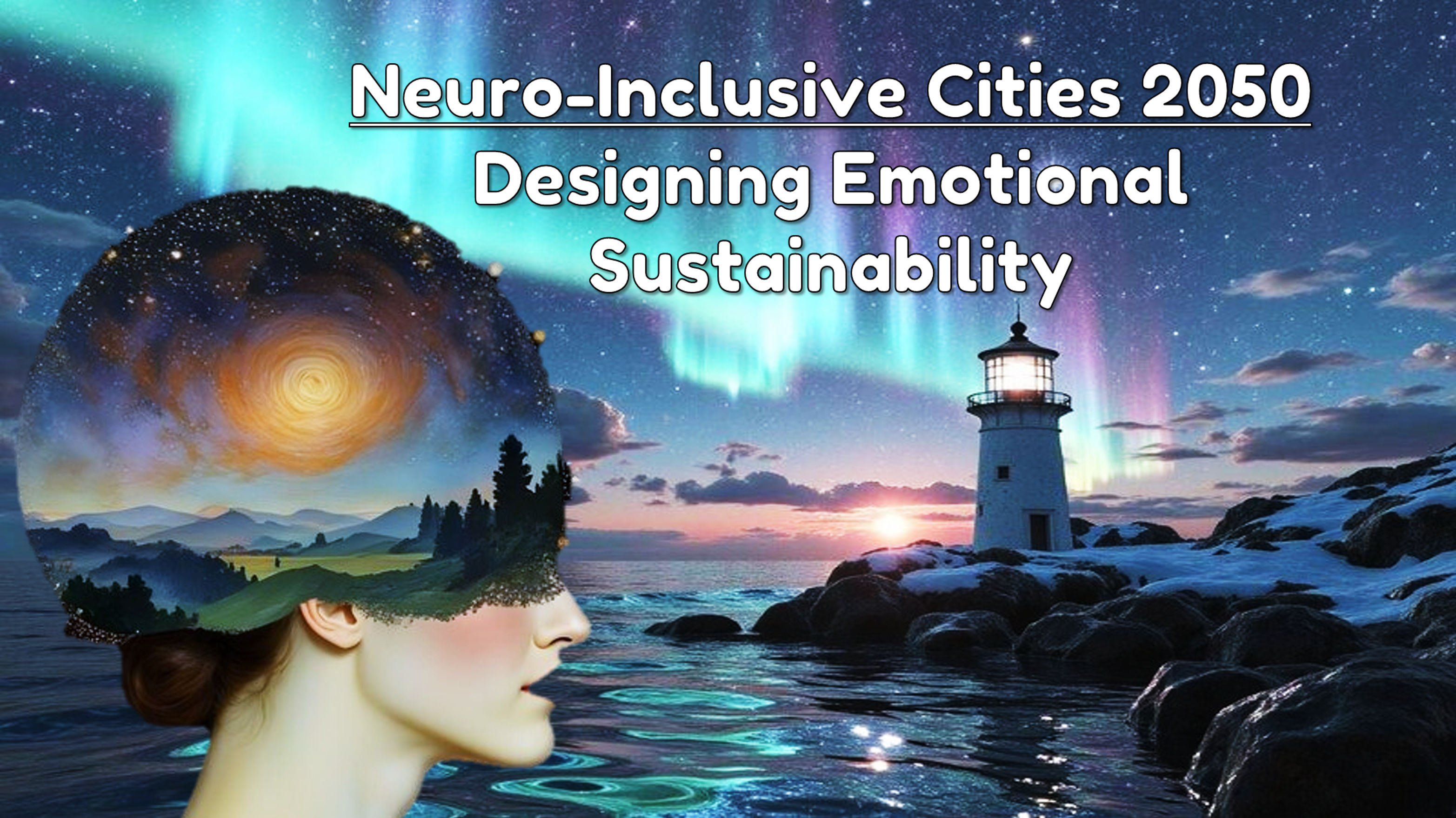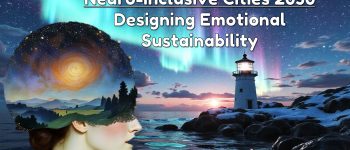Cities have been designed for ages to optimize infrastructure, economy, and efficiency. The 21st century’s urbanization forgot one crucial aspect-emotional well-being and neuro-inclusivity. Modern cities are usually very fast and overcrowded. These conditions tend to overwhelm the individual, particularly the neuro-diverse, the ones with high emotional sensitivity, and those struggling with mental health.
Main Issues:
1. Sensory Overload: Bright lights, loud sounds, crowded, and chaotic places are overwhelmingly uncomfortable and distressing for children with autism, ADHD, anxiety, and sensory processing disorders.
2. Social Isolation: Urban people residing in high density areas have few emotionally supportive places to feel socially connected.
3. Increasing rates of anxiety, depression, and burnout are attributed to high stress levels, urban loneliness, and overstimulation from a poor environment.
The proposition of this project is a paradigm shift: urban design reimagined through AI-driven emotional ecosystems and neuro-inclusive spaces as adaptive, responsive, and supportive environments for everyone.
Core Innovations: AI-Responsive Emotional Ecosystems
Cities will need to transform by 2050 from static infrastructure to emotionally intelligent environments that dynamically change in response to human emotions in real time. This project brings in AI-driven emotional ecosystems – smart environments, equipped with the processing of real-time emotional data, which are designed to respond to and improve mental well-being.
1. AI-Responsive Public Spaces: Adapting to Emotional Needs
Future cities will have emotionally responsive public spaces, along with AI and biometric technology, which will be designed to detect stress levels, anxiety, and even sensory overload. These spaces will comprise smart lighting systems that adjust brightness and warmth based on crowd density and individual stress levels. There will also be soundscapes which adapt by reducing background noise in high-stress zones or playing soothing sounds in specially designated relaxation areas. Air quality and temperature control according to the emotional states sensed, which guarantee a psychosomatic peace environment. A subway station in 2050 might be sensing stress in the peak hour through facial recognition and biometric feedback. AI systems are going to dim bright lights, reduce the decibel level, and provide soothing images or audio to relieve commuter stress.
2. Neuro-Inclusive Zones: Sensory-Friendly Spaces for All
Public spaces, workplaces, and transit hubs should have well-defined sensory-sensitive areas for neurodiverse people and those looking to withdraw from overstimulation. These areas should include:
a. Office and mall spaces with noise-free pods and seating that can be controlled via sensors for optimal adjustments.
b. Dynamic walls that change the color and texture according to the user’s emotional needs.
c. Calming zones with natural designs, ambient lights adjustable by artificial intelligence.
For instance, a university campus in 2050 will include sensory-friendly study zones with settings for light and sound that ensure students with sensitivity to sensory aspects can focus and learn in the most comfortable manner.
3. Emotionally Intelligent Architecture: Homes That Respond to Feelings
Buildings and homes are going to become emotionally responsive places that change atmosphere according to how the residents are feeling. Such buildings will come equipped with key features such as:
a. Smart windows tinting according to the user’s stress levels
b. Interactive walls providing customizable textures as well as views for relaxation, stimulation, etc.
c. AI powered home assistants guided the user toward breathing exercises and mindfulness activities combined with cognitive therapies when distress would be detected in the user.
For instance, an apartment apartment in 2050 will sense when one of the residents is anxious and will automatically adjust to warm lighting, play soothing music, and deliver mindfulness exercises through AI assistants.
4. AI-Based Mental Health Support: Urban Therapy Networks
AI-based mental health systems will be implemented within cities for real-time emotional guidance and crisis intervention. Such systems will comprise:
a. Public therapy booths with AI technology, allowing for on-the-spot emotional support
b. Chatbots and virtual therapists that can be accessed in city centers to get mental health exercises and stress management techniques
c. Wearable emotional sensors that are linked to the AI network of cities so that public spaces can adapt based on collective emotional feedback.
For instance, a stressed person in a park will be provided with real-time suggestions for relaxation via augmented reality (AR) headsets or mobile devices, leading them to the direction of calm zones, meditation areas, or interactive therapeutic installations.
5. Adaptive Green Spaces: Urban Parks That Heal
Green spaces will become emotionally responsive sanctuaries that integrate nature, technology, and mental health support. Some of the features include:
a. Interactive air purification systems controlled by AI that enhance air quality according to emotional well-being indicators.
b. Biofeedback Gardens interacting with visitors through color, sounds, and texture changes based on the mood.
c. Therapeutic landscapes supporting interactive art, awakening emotional expression, and mindfulness.
For instance, a 2050 city park may have AI-controlled meditation zones whose environment aligns with user emotions- fine, changing scents, visuals, and sound therapy for stress relief.
6. Emotionally Inclusive Transport- No More Stressed-Out Commutes
Public transportation will include sensory-sensitive and neuro-inclusive features to optimize the calm commuting experience:
a. Quiet zones with soundproofing and customizable lighting
b. AI-assisted navigation that suggests low-stress travel routes based on emotional data.
c. Train and bus interiors can be designed to adapt according to the needs of people who require space and comfort, through adjustable seating arrangements.
For example, a metro system in 2050 will use real-time emotional analytics to automatically adjust carriage environments, reducing crowding, noise, and light intensity to match commuter needs.
Vision 2050: Cities of Emotion: Building Emotional Resilience.
By integrating psychology, technology, and inclusive design, this project will create the future of cities that not only function but also heal, support, and improve emotional well-being.
– Urban space will no longer be static, but dynamic, adaptive, and flexible.
– Mental health support will be integrated into the fabric of everyday life.
– Neurodiverse individuals will experience the city as an accessible, supportive environment rather than a source of distress.
This will redesign urban living by integrating emotional intelligence into city planning, with the promise that by 2050, cities will be places where people thrive emotionally, not just survive physically.
My Approach:
To solve this problem, I suggest designing AI-driven emotional ecosystems and neuro-inclusive urban spaces that emphasize emotional health alongside functionality. My approach includes:
a. Real-time emotional feedback systems where aspects of the environment, like lighting, sound, and temperature, are manipulated in response to emotional data, providing a comfortable, adaptive living environment for its residents.
b. Spaces designed to decrease overstimulation, using soothing materials, adaptable lighting, and quiet zones tailored for those who suffer from sensory processing issues, allowing them comfort and relaxation.
c. Emotionally intelligent public spaces that nurture social connection, mental well-being, and community building by including features that enhance inclusivity through supportive spaces for socializing, meditative zones, and sensory-safe areas.
My project brings together psychology, technology, and inclusive design to create urban spaces that not only function but also support the emotional needs of all residents. Addressing the emotional and cognitive requirements of the community will help in creating cities that are not only sustainable but also emotionally supportive,


